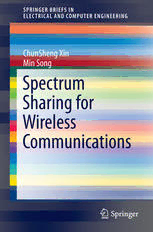Table Of ContentSpringerBriefs in Electrical and Computer
Engineering
Forfurthervolumes:
http://www.springer.com/series/10059
ChunSheng Xin • Min Song
Spectrum Sharing for
Wireless Communications
2123
ChunShengXin MinSong
ElectricalandComputerEngineeringDepartment ComputerScienceDepartment
OldDominionUniversity MichiganTechnologicalUniversity
Norfolk,Virginia Houghton,Michigan
USA USA
ISSN2191-8112 ISSN2191-8120(electronic)
SpringerBriefsinElectricalandComputerEngineering
ISBN978-3-319-13802-2 ISBN978-3-319-13803-9(eBook)
DOI10.1007/978-3-319-13803-9
LibraryofCongressControlNumber:2015932427
SpringerChamHeidelbergNewYorkDordrechtLondon
© TheAuthor(s)2015
Thisworkissubjecttocopyright.AllrightsarereservedbythePublisher,whetherthewholeorpartofthe
materialisconcerned,specificallytherightsoftranslation,reprinting,reuseofillustrations,recitation,
broadcasting,reproductiononmicrofilmsorinanyotherphysicalway,andtransmissionorinformation
storageandretrieval,electronicadaptation,computersoftware,orbysimilarordissimilarmethodology
nowknownorhereafterdeveloped.
Theuseofgeneraldescriptivenames,registerednames,trademarks,servicemarks,etc.inthispublication
doesnotimply,evenintheabsenceofaspecificstatement,thatsuchnamesareexemptfromtherelevant
protectivelawsandregulationsandthereforefreeforgeneraluse.
Thepublisher,theauthorsandtheeditorsaresafetoassumethattheadviceandinformationinthisbook
arebelievedtobetrueandaccurateatthedateofpublication.Neitherthepublishernortheauthorsorthe
editorsgiveawarranty,expressorimplied,withrespecttothematerialcontainedhereinorforanyerrors
oromissionsthatmayhavebeenmade.
Printedonacid-freepaper
SpringerispartofSpringerScience+BusinessMedia(www.springer.com)
Acknowledgements
We would like to express our warm appreciation to Old Dominion University and
MichiganTechnologicalUniversity.WewouldliketothankProfessorXuemin“Sher-
man”ShenandtheSpringerstaffwhohelpedustopublishourwork.Specialthanks
go to U.S. National Science Foundation, in particular the NeTS, EARS, and CA-
REER programs. Last but certainly not least, we want to thank our families, who
neverstoppedsupportingandencouragingus.
v
Contents
1 Introduction.................................................. 1
1.1 SpectrumManagement..................................... 2
1.2 CognitiveRadio........................................... 3
1.3 SpectrumSharing ......................................... 4
References.................................................... 5
2 OpportunisticSpectrumAccess................................. 7
2.1 SensingBasedOpportunisticSpectrumAccess................. 7
2.1.1 SpectrumSensing................................... 7
2.1.2 SpectrumAccessandSpectrumHandoff................ 10
2.1.3 ChallengesfortheOSAArchitecture................... 12
2.2 Geo-LocationBasedSpectrumAccess ........................ 12
2.2.1 TVBandUsage..................................... 13
2.2.2 TVWhiteSpaceAvailability.......................... 13
2.2.3 TVWhiteSpaceAccess.............................. 14
References.................................................... 16
3 IncentivizedCooperativeDynamicSpectrumAccess .............. 17
3.1 Introduction .............................................. 17
3.2 TheIC-DSAArchitecture................................... 18
3.3 AnalysisofIC-DSAPerformance ............................ 19
3.4 ANewNetworkCodingScheme............................. 23
3.5 NumericalResults......................................... 27
References.................................................... 31
4 DynamicSpectrumCo-Access .................................. 33
4.1 Introduction .............................................. 33
4.2 DSCAwithOnePUNodePairandOneSUNodePair .......... 34
4.2.1 CoexistenceConstraints.............................. 36
4.3 DSCAwithaMulti-HopPUNetwork ........................ 37
4.4 RegionofCoexistence ..................................... 40
vii
viii Contents
4.5 CoexistenceLinksSelection ................................ 42
4.6 PerformanceEvaluation .................................... 43
References.................................................... 47
5 On-DemandSpectrumAccess .................................. 49
5.1 Introduction .............................................. 49
5.2 SpectrumService.......................................... 50
5.3 BandAllocationforPP-SB-IEService ........................ 53
5.4 BandAllocationforPP-SB-IMService ....................... 55
5.4.1 AnalysisofBandAllocationforPP-SB-IMService....... 60
5.5 PerformanceEvaluation ................................... 62
References.................................................... 64
6 Conclusions .................................................. 65
Reference..................................................... 66
Chapter 1
Introduction
Wireless technology plays a significant role in the national economy. The number
ofwirelessdeviceshasbeengrowingexponentiallyinrecentyears,includingsmart
phones,tablets,GPSreceivers,babymonitors,remotecontrollers,wirelesssensors,
unmannedaircraftsystems,etc.Today,thereareabout5–7billionwirelessdevices.
Thisnumberisprojectedtoreach100billionsby2025,asillustratedinFig.1.1.In
recentyears,thewirelesstrafficvolumehasalsobeendoublingabouteveryyear.In
addition, wirelessapplicationsaregrowingquickly. BesidesGPS,cellularphones,
WiFi,satelliteTV,andpublicsafetycommunications,newapplicationsareemerging,
e.g.,smarthome,e-health,e-commerce,andintelligenttransportationsystems,just
name a few. The fast growing wireless devices and applications have created an
unprecedenteddemandtoradiospectrum.However,theradiospectrumisalimited
resource, and has become extremely valuable in recent years, thanks to the ever-
increasingdemand.Figure1.2showstheallocationofradiospectrumintheUnited
States.Wecanseethatalmostallofthespectrumthathasgoodpropagationproperty
desiredbywirelesscommunicationshasbeenallocated.Today,thereislittlespectrum
leftforfuturespectrumdemands,aproblemknownasspectrumscarcity.Infact,it
hasbecomeverycostlytoobtainalicenseforanewspectrumband. Forexample,
thespectrumauctionin2006intheUnitedStatesyielded13.6billionsfor95MHz
spectrum.Themajormobileoperatoreachhasspenttensofbilliondollarstopurchase
ortradespectruminrecentyears.
The spectrum scarcity problem has a tremendous impact on the national econ-
omy, and has drawn the attention from the spectrum regulation agencies, research
community, funding agencies, all the way to the highest level. Fortunately, many
studies have shown that the spectrum scarcity is artificial and mainly created by
today’s static spectrum allocation policy, rather than the lack of spectrum. As a
matteroffact, manystudieshavefoundthatthelicensedspectrumisconsiderably
under-utilized in temporal, spatial, and frequency domains [1, 2]. These findings
have spawned a great interest on the research of spectrum sharing, to enable sec-
ondary users or devices to access the unused licensed spectrum provided that the
primaryusersofthelicensedbandsarenotharmfullyinterfered.Inthelastdecade,
theFCC,DARPA,NSF,andotheragencieshavebeenveryactivetosupportrelated
©TheAuthor(s)2015 1
C.Xin,M.Song,SpectrumSharingforWirelessCommunications,
SpringerBriefsinElectricalandComputerEngineering,DOI10.1007/978-3-319-13803-9_1
2 1 Introduction
Fig.1.1 Exponentialgrowth
billions
ofwirelessdevices
N
u 100
m
b
e
r o
f W
ire 50
le
s
s
D
e
vic 5
e
s
2010 2015 2020 2025 Year
research including architectures, protocols, algorithms, enabling technologies, ra-
dioplatforms,andtestbeds,throughvarioustargetprograms,includingtheDARPA
XG, WNaN, and SSPARC programs, and the NSF ProWin and EARS programs.
Today, spectrum sharing and cognitive communications have become a focus area
ofmajornetworkingandcommunicationconferences,suchasIEEEInfocom,ICC,
Globecom,tonameafew.
1.1 SpectrumManagement
Traditionally, the spectrum management takes a static, command and control ap-
proach. The spectrum regulation agency usually determines the services to be
providedonaspectrumband,e.g.,broadcastTVonthebandfrom470to700MHz.
Fig.1.2 SpectrumallocationmapintheUnitedStates
1.2 CognitiveRadio 3
Theserviceprovidersapplyforlicensestooperateonaspectrumband,toofferthe
servicesdesignatedbythespectrumregulationagency.Thelicenseapplicationand
approval is usually time consuming. Nevertheless, once it is approved, a license
can be held for a significant period of time, e.g., 10 or 20 years, and is renewable
if needed, to protect the significant investment on the infrastructure by the service
provider.Thelicenseduserhasexclusiveaccesstothelicensedspectrumband.
Thestaticspectrummanagementhasworkedwellinpastdecades,andeffectively
protectsthelicensedusersfrominterference. However, suchstatic, dedicated, and
mutually exclusive spectrum allocation is wasteful, and has created the spectrum
scarcity problem. On the other hand, the rapidly proliferated wireless devices and
servicesinrecentyearshavecreatedanever-increasingdemandforradiospectrum.
Drivenbythisfastincreasingdemandforradiospectrumandtheinabilityofthetra-
ditionalstaticspectrummanagementtoaddressthedemand,thespectrumallocation
policies have been under reform in recent years, with the objective to allow unli-
censedorsecondaryusers(SUs)todynamicallyaccesstheunusedlicensedbands,
providedthattheydonotcauseharmfulinterferencetothelicensedorprimaryusers
(PUs). The unused spectrum in the temporal, spatial, and frequency domains are
calledspectrumholes orwhitespaces. Theyofferagreatopportunityfordynamic
spectrumsharingbetweenSUsandPUs,torelievetheincreasingdemandforspec-
trum. Specifically, SUsdynamicallysearchforidlelicensedspectrumbands, such
astheidlebroadcastTVchannels(TVwhitespaces), throughspectrumsensingor
ageo-locationdatabase,andaccessthesespectrumbandsfordatacommunications
[3].ToavoidinterferencetoPUs,SUsneedtoyieldtoPUswheneverPUsstartusing
theband.
1.2 CognitiveRadio
ThedynamicspectrumsharingbetweenSUsandPUsismadepossiblebyarecent
innovation in radio technology–cognitive radio, which is spectrum agile and can
senseitsspectrumenvironmentandintelligently accessidlespectrumbandsthatare
unusedbyPUs.Traditionally,theradiousedforwirelesscommunicationsisimple-
mented completely by hardware, and typically operates on a fixed spectrum band
withafixedwaveformonly.Inthelastdecade,theconceptofsoftwaredefinedradio
orcognitiveradiohasbeenproposedintheliterature[4–6].Severalcognitiveradio
platformshavebeendeveloped,suchastheGNUradio/USRPfromtheGNUproject
andtheEttusResearch,theWiNC2RradiofromWINLABoftheUniversityofNew
JerseyatRutgers,theKUAgileRadiofromtheUniversityofKansas,andtheWARP
from Rice University and Mango Communications. The cognitive radio typically
consists of a minimal analog RF front-end, analog-to-digital and digital-to-analog
converters,andadigitalprocessingengine,whichistypicallyanuser-programmable
FPGAboard,aDSPprocessor,orevenageneral-purposeprocessor,asillustratedin
Fig.1.3.InthecasethatthedigitalprocessingengineisanFPGAoraDSPprocessor,
itisconnectedtoaworkstationoralaptopthatisusedtoprogramtheFPGAorthe

